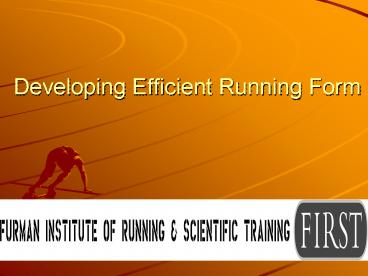Developing Efficient Running Form - PowerPoint PPT Presentation
1 / 22
Title:
Developing Efficient Running Form
Description:
Start Line. Finish Line. A. B. 100 Meters ... The view of the end of the race as runner B crosses the finish line. What happened to runner A? ... – PowerPoint PPT presentation
Number of Views:870
Avg rating:5.0/5.0
Title: Developing Efficient Running Form
1
Developing Efficient Running Form
2
SOME BASICS ON THEBIOMECHANICS Of RUNNING
3
Running Gait
- Running Gait
- a. There are times when there is only one
foot on the ground (single leg support). - b. There are times when there is no
support (flight phase).
4
Components Of The Running Gait
- Stride Rate The number of steps taken during a
given time period (usually a minute). Units of
steps/minute. - A stride is composed of 2 steps, but some
will equate strides and steps. You - need to be aware of this.
- Stride Length The length of a stride. Units of
length/step.
5
Stride
Step
6
Stride Rate of Olympians
- Jack Daniels, at the 1984 Olympics,
- Spent most of his time counting the
- stride rates of runners in races of
different - distances
- Stride Rates of 90 or 180 steps/minute
- This was the most common running
- cadence
- Counting steps is one of Daniels first
- objectives for new runners
7
Running Speed
- Function of Stride Length and Stride Rate
- Stride Length x Stride Rate
meters/step x steps/min meters/min (m/min)
8
The Race
Start Line
Finish Line
Viewed from Helicopter
A
A
100 Meters
B
B
Runners are identical twins running the same race
at the same velocity. Who will win?
9
The Race
Start Line
Finish Line
Viewed from Helicopter
A
A
100 Meters
B
B
The view of the end of the race as runner B
crosses the finish line. What happened to runner
A?
10
The Race
Start Line
Finish Line
Viewed from Side
A
101.5 Yards
A
Center of Mass
B
B
100 Yards
11
Lifting Center of Mass
Too much of the GRF is in the up direction.
Center of Mass travels too high.
12
Toe is not pointed straight ahead, prevents
optimal transfer of momentum
Toe straight ahead, the transfer of center of
mass efficient.
13
Body Rotation
- Arm Motion During Running Used primarily as
counter to rotation to leg motion. - Excessive upper body rotation can result in
reducing optimal transfer of momentum during
running cycle.
14
(No Transcript)
15
RUNNING FORM AND TECHNIQUE
16
POSTURE
- Trunk Erect
- Head Level
- Hips Tall
- Relaxed Upper Body
17
Stride
- Will vary from Runner to Runner
- Forward Not up and Down
- Quick and Light
- No exaggeration knee lift
18
ARMS
- Used for balance
- Initiates the action of the legs
- Elbow angles vary from 60 140 degrees
- Arms and fists relaxed
- Arms should not cross midline of your body
19
Elasticity Efficiently
- Generates more force on each stride
- (push off the ground harder)
- Run farther and faster with less effort
- Will help minimize running injuries
- Stimulates central nervous system
20
Ways to Improve Running Form
- Strength Training
- Stretching
- Strides
- Drills
- Fast Running
21
Drills to Improve Running Form
- Hand out with drills and descriptions
22
Next FIRST LectureMarch 7th 8thImproving
Your Speed at the TrackDemonstration / audience
participation

